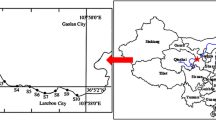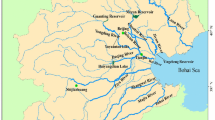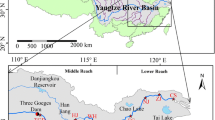Abstract
The Liao River drainage basin, which is one of China’s seven major rivers basins, is located in northeast China. This region is characterized by important industrial bases including steel factories and oil and chemical plants, all of which have the potential to contribute pollutants to the drainage basin. In this study, 16 polycyclic aromatic hydrocarbons (PAHs) in water and suspended particulate matter (SPM) in the major rivers of the Liao River drainage basin were identified and quantified by gas chromatography mass spectrometry (GC/MS). The total PAH concentrations ranged from 0.4 to 76.5 μg/g (dry weight) in SPM and 32.6 to 108 ng/L in surface water, respectively. Low-ring PAHs (including two- and three-ring PAHs) were dominant in all PAH samples, and the level of low-ring PAHs in surface water was higher than that in SPM. The proportion of two-ring PAHs was the highest, accounting for an average of 68.2 % of the total PAHs in surface water, while the level of three-ring PAHs was the highest in SPM, with an average of 66.3 %. When compared with other river systems, the concentrations of PAHs in the Liao River drainage basin were lower. Identification of the emission sources based on diagnostic ratios suggested petroleum and fossil fuel combustion were important contribution to PAHs in the study area.




Similar content being viewed by others
References
Barreca, S., Bastone, S., Caponetti, E., Chillura Martino, D. F., & Orecchio, S. (2014). Determination of selected polyaromatic hydrocarbons by gas chromatography-mass spectrometry for the analysis of wood to establish the cause of sinking of an old vessel (Scauri wreck) by fire. Microchemical Journal, 117(1), 116–121.
Bergamasco, A., Culotta, L., De Stefano, C., Orecchio, S., Sammartano, S., Barreca, S., et al. (2014). Composition, distribution and sources of polycyclic aromatic hydrocarbons in sediments of the Gulf of Milazzo (Mediterranean Sea, Italy). Polycyclic Aromatic Compounds, 34(4), 397–424.
Cao, Z., Wang, Y., Ma, Y., Xu, Z., Shi, G., Zhuang, Y., Zhu, T., et al. (2005). Occurrence and distribution of polycyclic aromatic hydrocarbons in reclaimed water and surface water of Tianjin, China. Journal of Hazardous Materials, 122(1–2), 51–59.
Chen, B., Xuan, X., Zhu, L., Wang, J., Gao, Y., Yang, K., Lou, B., et al. (2004). Distributions of polycyclic aromatic hydrocarbons in surface waters, sediments and soils of Hangzhou City, China. Water Research, 38(16), 3558–3568.
Dickhut, R. M., Canuel, E. A., Gustafson, K. E., Liu, K., Arzayus, K. M., Walker, S. E., MacDonald, E. H., et al. (2000). Automotive sources of carcinogenic polycyclic aromatic hydrocarbons associated with particulate matter in the Chesapeake Bay Region. Environmental Science & Technology, 34(21), 4635–4640.
Doong, R. A., & Lin, Y. T. (2004). Characterization and distribution of polycyclic aromatic hydrocarbon contaminations in surface sediment and water from Gao-ping River, Taiwan. Water Research, 38(7), 1733–1744.
Du, Q. G. (2004). Stratagem study on sustainable development and environmental protection in Liaoning province (1st Edn., pp. 11–15). Beijing: Science (in Chinese).
Fang, G.-C., Chang, C.-N., Wu, Y.-S., Fu, P. P.-C., Yang, I. L., Chen, M.-H., et al. (2004). Characterization, identification of ambient air and road dust polycyclic aromatic hydrocarbons in central Taiwan, Taichung. Science of the Total Environment, 327(1–3), 135–146.
Fernandes, M. B., Sicre, M.-A., Boireau, A., & Tronczynski, J. (1997). Polyaromatic Hydrocarbon (PAH) distributions in the Seine River and its Estuary. Marine Pollution Bulletin, 34(11), 857–867.
Frenna, S., Mazzola, A., Orecchio, S., Tuzzolino, N., et al. (2013). Comparison of different methods for extraction of polycyclic aromatic hydrocarbons (PAHs) from Sicilian (Italy) coastal area sediments. Environmental Monitoring and Assessment, 185(7), 5551–5562.
Gustafson, K. E., & Dickhut, R. M., (1997). Distribution of polycyclic aromatic hydrocarbons in Southern Chesapeake Bay surface water: evaluation of three methods for determining freely dissolved water concentrations. Environmental Toxicology and Chemistry, 16(12), 452–461.
IARC (2001). Monographs programme on the evaluation of carcinogenic risks to humans, Lyon, France.
Johnsen, A. R., Wick, L. Y., Harms, H., et al. (2005). Principles of microbial PAH-degradation in soil. Environmental Pollution, 133(1), 71–84.
Khalili, N. R., Scheff, P. A., Holsen, T. M., et al. (1995). PAH source fingerprints for coke ovens, diesel, and gasoline engines, highway tunnels, and wood combustion emissions. Atmospheric Environment, 29(4), 533–542.
Li, G., Xia, X., Yang, Z., Wang, R., & Voulvoulis, N. (2006). Distribution and sources of polycyclic aromatic hydrocarbons in the middle and lower reaches of the Yellow River, China. Environmental Pollution, 144(3), 985–993.
Li, Y., Liu, J., Cao, Z., Lin, C., & Yang, Z. (2010). Spatial distribution and health risk of heavy metals and polycyclic aromatic hydrocarbons (PAHs) in the water of the Luanhe River Basin, China. Environmental Monitor Assessment, 163(1), 1–13.
Mai, B.-X., Fu, J.-M., Sheng, G.-Y., Kang, Y.-H., Lin, Z., Zhang, G., Zeng, E. Y., et al. (2002). Chlorinated and polycyclic aromatic hydrocarbons in riverine and estuarine sediments from Pearl River Delta, China. Environmental Pollution, 117(3), 457–474.
Malik, A., Verma, P., Singh, A., Singh, K., et al. (2011). Distribution of polycyclic aromatic hydrocarbons in water and bed sediments of the Gomti River, India. Environmental Monitoring and Assessment, 172(1-4), 529–545.
Manoli, E., Samara, C., Konstantinou, I., Albanis, T., et al. (2000). Polycyclic aromatic hydrocarbons in the bulk precipitation and surface waters of Northern Greece. Chemosphere, 41(12), 1845–1855.
Maskaoui, K., Zhou, J. L., Hong, H. S., Zhang, Z. L., et al. (2002). Contamination by polycyclic aromatic hydrocarbons in the Jiulong River Estuary and Western Xiamen Sea, China. Environmental Pollution, 118(1), 109–122.
Menzie, C. A., Potocki, B. B., Santodonato, J., et al. (1992). Exposure to carcinogenic PAHs in the environment. Environmental Science & Technology, 26(7), 1278–1284.
Mitra, S., & Bianchi, T. (2003). A preliminary assessment of polycyclic aromatic hydrocarbondistributions in the lower Mississippi River and Gulf of Mexico. Marine Chemistry, 82(3), 273–288.
Nagy, A. S., Simon, G., Szabó, J., Vass, I., et al. (2013). Polycyclic aromatic hydrocarbons in surface water and bed sediments of the Hungarian upper section of the Danube River. Environmental Monitoring and Assessment, 185(6), 4619–4631.
Orecchio, S. (2010). Assessment of polycyclic aromatic hydrocarbons (PAHs) in soil of a natural reserve (Isola delle Femmine) (Italy) located in front of a plant for the production of cement. Journal of Hazardous Materials, 173(1-3), 358–368.
Orecchio, S., Cannata, S., Culotta, L., et al. (2010). How building an underwater pipeline connecting Libya to Sicilian coast is affecting environment: polycyclic aromatic hydrocarbons (PAHs) in sediments; monitoring the evolution of the shore approach area of the Gulf of Gela (Italy). Journal of Hazardous Materials, 181(1-3), 647–658.
Patrolecco, L., Ademollo, N., Capri, S., Pagnotta, R., Polesello, S., et al. (2010). Occurrence of priority hazardous PAHs in water, suspended particulate matter, sediment and common eels (Anguilla anguilla) in the urban stretch of the River Tiber (Italy). Chemosphere, 81(11), 1386–1392.
Qin, R., Wu, Y., Xu, Z., Xie, D., Zhang, C., et al. (2013). Assessing the impact of natural and anthropogenic activities on groundwater quality in coastal alluvial aquifers of the lower Liaohe River Plain, NE China. Applied Geochemistry, 31, 142–158.
Rogge, W. F., Hildemann, L. M., Mazurek, M. A., Cass, G. R., Simoneit, B. R. T., et al. (1993). Sources of fine organic aerosol. 2. Noncatalyst and catalyst-equipped automobiles and heavy-duty diesel trucks. Environmental Science & Technology, 27(4), 636–651.
Shi, Z., Tao, S., Pan, B., Fan, W., He, X. C., Zuo, Q., et al. (2005). Contamination of rivers in Tianjin, China by polycyclic aromatic hydrocarbons. Environmental Pollution, 134(1), 97–111
Simcik, M. F., Eisenreich, S. J., & Lioy, P. J. (1999). Source apportionment and source/sink relationships of PAHs in the coastal atmosphere of Chicago and Lake Michigan. Atmospheric Environment, 33(30), 5071–5079.
Song, X. Y., Hu, X. J., He, M. M., Liang, R. J., Li, Y. S., Li, F. M., et al. (2013). Distribution and sources of polycyclic aromatichydrocarbons in the surface water of Taizi River, Northeast of China. Environmental Monitoring and Assessment, 185(10), 8375–8382.
Tolosa, I., Bayona, J. M., Albaigés, J., et al. (1996). Aliphatic and polycyclic aromatic hydrocarbons and sulfur/oxygen derivatives in Northwestern Mediterranean sediments: spatial and temporal variability, fluxes, and budgets. Environmental Science & Technology, 30(8), 2495–2503.
Wang, X. C., Zhang, Y. X., Chen, R. F., et al. (2001). Distribution and partitioning of polycyclic aromatic hydrocarbons (PAHs) in different size fractions in sediments from Boston Harbor, United States. Marine Pollution Bulletin, 42(11), 1139–1149.
Yim, U. H., Hong, S. H., Shim, W. J., Oh, J. R., Chang, M., et al. (2005). Spatio-temporal distribution and characteristics of PAHs in sediments from Masan Bay, Korea. Marine Pollution Bulletin, 50(3), 319–326.
Yu, H. (2002). Environmental carcinogenic polycyclic aromatic hydrocarbons: photochemistry and phototoxicity. Journal of Environmental Science and Health. Part C, Environmental Carcinogenesis & Ecotoxicology Reviews, 20(2), 149–183.
Yunker, M. B., Macdonald, R. W., Vingarzan, R., Mitchell, R. H., Goyette, D., Sylvestre, S., et al. (2002). PAHs in the Fraser River basin: a critical appraisal of PAH ratios as indicators of PAH source and composition. Organic Geochemistry, 33(4), 489–515.
Zhang, Y., & Tao, S. (2008). Seasonal variation of polycyclic aromatic hydrocarbons (PAHs) emissions in China. Environmental Pollution, 156(3), 657–663.
Zhang, Z., Huang, J., Yu, G., Hong, H., et al. (2004). Occurrence of PAHs, PCBs and organochlorine pesticides in the Tonghui River of Beijing, China. Environmental Pollution, 130(2), 249–261.
Zhu, L. Z., Chen, B. L., Wang, J., Shen, H. X., et al. (2004). Pollution survey of polycyclic aromatic hydrocarbons in surface water of Hangzhou, China. Chemosphere, 56(11), 1085–1095.
Acknowledgments
This work was supported by the National Grand Science and Technology Special of China through grant 2012ZX07503-003-001, the National Natural Science Foundation of China through grant 40703021 and the Chinese Academy of Sciences for Key and Innovation Projects through grant KZCX2-EW-102. We also thank Professor Bixian Mai’s team in Guangzhou for their assistance with laboratory analysis.
Author information
Authors and Affiliations
Corresponding author
Rights and permissions
About this article
Cite this article
Hu, J., Liu, C., Zhang, G. et al. Distribution characteristics and source apportionment of polycyclic aromatic hydrocarbons (PAHs) in the Liao River drainage basin, northeast China. Environ Monit Assess 188, 227 (2016). https://doi.org/10.1007/s10661-016-5123-8
Received:
Accepted:
Published:
DOI: https://doi.org/10.1007/s10661-016-5123-8




